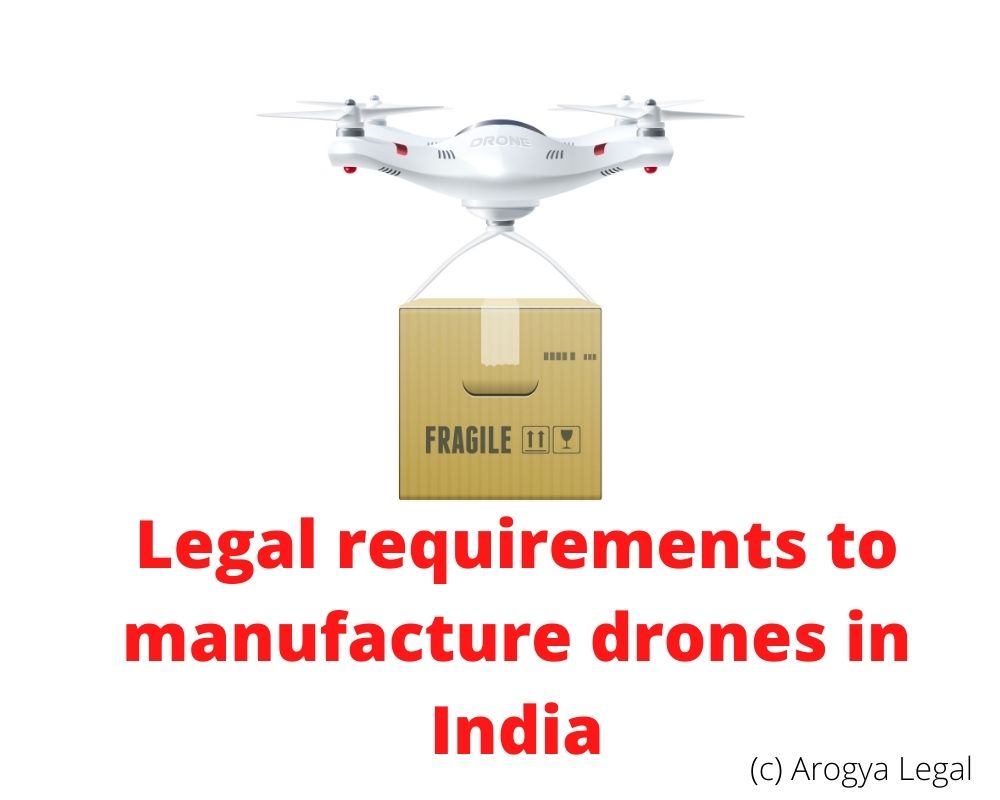Manufacturing drones [also referred to as Unmanned Aircraft System (UAS) or Remotely Piloted Aircraft System (RPAS)] in India is regulated by multiple laws including: Aircraft Act, 1934, Indian Wireless Telegraphy Act, 1933, Indian Telegraph Act, 1885 and Sea Customs Act, 1878 (as adopted by the Customs Act, 1962).
In this article, we have described the procedure that has to be followed for lawfully manufacturing drones in India.
Step 1- Obtaining Unique Authorization Number (UAN) for Manufacturer
Persons seeking to manufacture a drone have to first obtain a Unique Authorization Number (UAN) from the DGCA under the Unmanned Aircraft System Rules, 2021 (UAS Rules). It is important to note that only Indian citizens, enterprises (firms, partnerships etc.) and companies may seek authorization to manufacture drones.
Prior to making an application for authorization, the manufacturer has to first obtain security clearance from the Ministry of Civil Aviation (MCA) in consultation with Ministry of Home Affairs (MHA). The security clearance application may be made on the government portal https://e-sahaj.gov.in.
Upon receiving the security clearance, the manufacturer will have to submit an application to the DGCA in Form UA – 1 of UAS Rules along with the specified fee. The fee varies for each category of drone.
After the process of authorization is complete, the DGCA will provide a UAN for an authorized manufacturer. This UAN will be valid for a period of 10 years unless suspended, revoked or cancelled.
Any change thereafter to the credentials relevant to the eligibility criteria for obtaining the UAN has to be informed to the DGCA, and a fresh authorization will be issued thereafter if the eligibility conditions continue to be fulfilled.
Step 2 – Obtaining Equipment Type Approval for wireless system used in the Drone
An Equipment Type Approval (ETA) from the Wireless Planning & Coordination (WPC) Wing has to be obtained for every model and make of drone that is sought to be manufactured in India.
ETA can be obtained by making an application in the specified format to a Regional Licensing Officer (RLO) of the WPC Wing. The RLOs are located in Delhi, Mumbai, Kolkata, Chennai and Guwahati. An application form along with the technical literature, radio frequency reports from accredited labs and the requisite fees have to be submitted while applying for ETA.
An ETA issued for particular make and model of a prototype drone can be used by future users of the same make and model.
Step 3 – Obtaining Unique Prototype Identification Number
Any drone which has not been granted a Certificate Manufacture and Airworthiness (CMA) by DGCA cannot be used for sale and marketing purposes. In order to obtain a CMA, first a prototype of the drone has to be manufactured in India for testing at an approved laboratory.
In order to manufacture a prototype drone in India, the authorized manufacturer has to make an application for obtaining a Unique Prototype Identification Number, which is unique to the particular prototype drone and references the serial number. The application to obtain the Unique Prototype Identification Number has to be made as per Form UA – 2 of UAS Rules along with the specified fee.
The Unique Prototype Identification Number received from DCGA has to be affixed on the Prototype drone in an identifiable and visible manner.
Step 4 – Manufacturing a Prototype UAS
An authorized manufacturer can manufacture a prototype drone after obtaining the Unique Prototype Identification Number. The prototype drone is essential for the receiving the CMA.
Step 5 – Obtaining Certificate of Manufacture and Airworthiness (CMA)
Once the prototype drone has been manufactured in India, the authorized manufacturer is required to prove that the prototype drone is ‘airworthy’ i.e. it is capable of airborne operations as per the requirements stipulated by Indian law. A drone is considered to be airworthy only when it receives a Certificate of Manufacture and Airworthiness (CMA) from DGCA.
An authorized manufacturer can obtain a CMA by making an application under Form UA – 3 of UAS Rules to the DGCA with the specified fee. Please note that unmanned aircraft flight manual and maintenance manual should also be prepared and submitted along with Form UA – 3. On receipt of duly filled application, the DGCA allots an approved laboratory for testing of drones. Upon allotment, the authorized manufacturer has to submit the prototype drone which was manufactured in India along with design documents to the testing laboratory. The testing laboratory will test the prototype drone for its design, build and airworthiness. Once the testing laboratory validates the prototype drone and issues a test report, the DGCA will issue a CMA for specific type and class of a drone after being satisfied with the test report.
A drone can be lawfully manufactured in India after ensuring that the requirements stipulated in the steps mentioned above are complied with.

